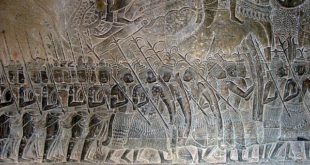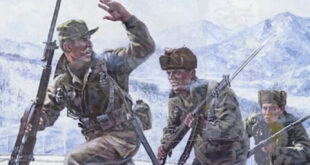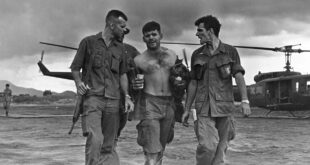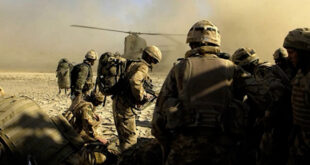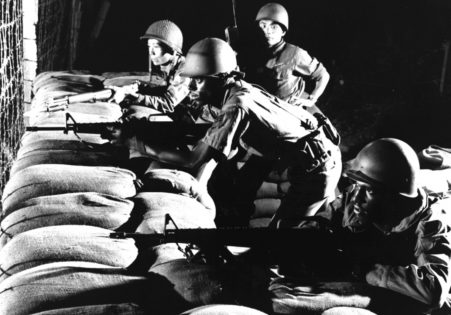
Vietnam
The aerial interdiction campaign against North Vietnam which began on 6 April 1972 with attacks in the southern part of the country expanded rapidly. On 16 April, B-52s, escorted by fighter and aircraft specializing in electronic countermeasures and suppression of surface-to-air missiles, bombed the fuel storage tanks at Haiphong, setting fires that, reflected from cloud and smoke, were visible from 110 miles away. Shortly afterward, carrier aircraft joined Air Force fighter-bombers in battering a tank farm and a warehouse complex on the outskirts of Hanoi. When these attacks failed to slow the offensive, naval aircraft began mining the harbors on 8 May, and two days later the administration extended the aerial interdiction campaign, formerly known as Freedom Train but now designated Linebacker, throughout all of North Vietnam.
In terms of tactics employed and results obtained, Linebacker was a vast improvement over Rolling Thunder. During Linebacker, American aircraft attacked targets like airfields, power plants, and radio stations which disrupted the flow of supplies and reinforcements to the units fighting in the South. Laser-guided bombs proved effective, especially against bridges, severing the bridge at Thanh Hoa, which had survived Rolling Thunder, and the highway and railroad bridges over the Red River at Hanoi. However, the enemy made use of alternate methods of crossing the streams, usually traveling at night on ferries or movable pontoon bridges. Electronic jamming as in Rolling Thunder confused the radars controlling the surface-to-air missiles and antiaircraft guns. North Vietnamese MiGs gave battle throughout Linebacker but they failed to gain control of the sky, in part because American radar detected enemy interceptors rising from runways, enabling controllers to direct Air Force F-4s and Navy fighters against them.
Nixon’s use of air power to disrupt supply lines and kill the enemy on the battlefield stopped the offensive and helped drive the enemy back a short distance without a reintroduction of the ground forces he had withdrawn from the South. In fact, the last combat troops of the U.S. Army departed in August 1972 while the South Vietnamese were counterattacking. Only 43,000 American airmen and support personnel remained. Yet the very success of the American aerial campaign caused misgivings in Saigon, where the South Vietnamese armed forces dependence on the Americans troubled President Thieu. When Thieu’s commanders failed during a recent offensive, the advisers took over, bringing to bear a volume of firepower that the South Vietnamese forces themselves could not generate. Thieu realized the Americans’ unilateral departure would leave South Vietnam at the mercy of the North Vietnamese forces still in his country. He balked at accepting what had come to be called a cease-fire in place, and the North Vietnamese also seemed uninterested in a settlement. President Nixon sought to remove first one and then the other obstacle to peace. He obtained Thieu’s reluctant assent to an in-place arrangement by offering “absolute assurance” that he intended to take “swift and severe retaliatory action” if North Vietnam should violate the terms of the agreement. He sought to remove the other roadblock, the stubborn attitude of the government in Hanoi, by ordering a resumption of the bombing of the heartland of North Vietnam.
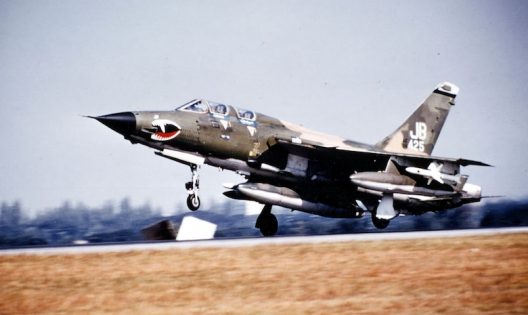
Operation Linebacker II operations were initiated on 18 December 1972 and were directed by the Joint Chiefs of Staff (JCS) to continue until further notice. The primary objective of the bombing operation would be to force the North Vietnamese government to enter into purposeful negotiations concerning a cease-fire agreement. The operation employed air power to its maximum capabilities in an attempt to destroy all major target complexes such as radio stations, railroads, power plants, and airfields located in the Hanoi and Haiphong areas. Unlike previous bombing campaigns, Linebacker II provided the Air Force and U.S. Naval forces with specific objectives and removed many of the restrictions that had previously caused frustration within the Pentagon.
During these operations, Air Force and Navy tactical aircraft and B-52s commenced an around-the-clock bombardment of the North Vietnamese heartland. The B-52s struck Hanoi and Haiphong during hours of darkness with F-111s and Navy tactical aircraft providing diversionary/suppression strikes on airfields and surface-to-air missile sites. Daylight operations were primarily carried out by A-7s and F-4s bombing visually or with long-range navigation (LORAN) techniques, depending upon the weather over the targets. In addition, escort aircraft such as the Air Force EB-66s and Navy EA-6s broadcast electronic jamming signals to confuse the radar-controlled defenses of the North. The Strategic Air Command also provided KC-135s to support the in-flight refueling requirements of the various aircraft participating in Linebacker II operations. The impact of the bombing was obvious in the severe damage to the North Vietnamese logistic and war-support capability. By 29 December 1972, the 700 nighttime sorties flown by B-52s and 650 daytime strikes by fighter and attack aircraft persuaded the North Vietnamese government to return to the conference table.
The United States paid a price for the accomplishments of Linebacker II. During bombing raids, U.S. Air Force and U.S. Navy aircraft encountered intense enemy defensive actions that resulted in the loss of twenty-six aircraft in the twelve-day period. Air Force losses included fifteen B-52s, two F-4s, two F-111s, and one HH-53 search and rescue helicopter. Navy losses included two A-7s, two A-6s, one RA-5, and one F-4. Seventeen of these losses were attributed to SA-2 missiles, three to daytime MiG attacks, three to antiaircraft artillery, and three to unknown causes.
See these AFHSO publications
Linebacker II: A View From the Rock by James R. McCarthy and George B. Allison
To Hanoi and Back by Wayne Thompson.
See the AFHSO publication by Bernard C. Nalty: Air War Over South Vietnam, 1968-1975.
 Soldier of Fortune Magazine The Journal of Professional Adventurers
Soldier of Fortune Magazine The Journal of Professional Adventurers


